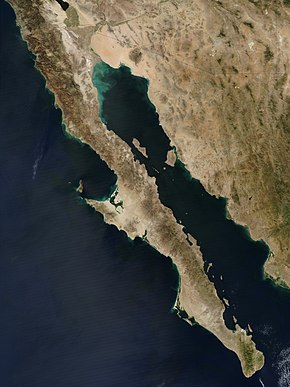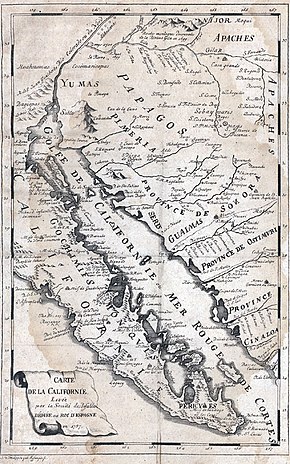Baja California
| Baja California | ||
 Satellite image of Baja California |
||
| Geographical location | ||
|
|
||
| Coordinates | 28 ° N , 114 ° W | |
| Waters 1 | Pacific Ocean | |
| Waters 2 | Gulf of California | |
| length | 1 200 km | |
| width | 220 km | |
| surface | 143,396 km² | |
 Map from 1766 |
||
Baja California ( Spanish Baja California ) is a narrow peninsula in the west of Mexico of 1200 kilometers in length and 80 to 220 km wide. It lies parallel to the Mexican west coast and merges with the Mexican mainland at its northern end. On it lie the Mexican states of Baja California Sur (southern Baja California ) and Baja California ( Baja California ), which stretches north over the Mexican mainland to the US state California . It is as large as the Apennine peninsula in Italy and about twice as long as the US - State of Florida . The Sonora desert , which also extends over large parts of the mainland, takes up most of its area . The origin of the name “California” is unclear, it is probably taken from the chivalric novel Las Sergas de Esplandián by Garci Rodríguez de Montalvo or is derived from the name calida forna - “hot oven”. The region around the peninsula is tectonically active, the Caldera Aguajito was formed during a volcanic eruption about 760,000 years ago.
The peninsula is bordered by the Pacific Ocean to the west and the Gulf of California to the east. The two coasts are very different. In the cold currents of the Pacific coast from the north and from the depths, whales can be seen migrating to and from their breeding sites further south.
The Gulf, with its warmer waters, on the other hand, is more comparable to the Mediterranean . In the north, the Colorado River flows into the Gulf. In the northern gulf there are strong currents in the shallow water due to the high tidal range at ebb and flow. In contrast, further south the gulf is sometimes very calm. In some places you can see interesting phenomena of bioluminescence at night , and you can see seals or dolphins hunting fish. There are important fishing grounds off the Pacific coast.
The peninsula has a unique flora and fauna. Mention may be made herein bipes , side-blotched lizard , Frans toes iguanas , Sidewinder Rattlesnake , the Kit Fox , the Hoskins-pygmy owl and the Cardon cactus , Ocotillos , the Boojum and saguaro cactus . The Craveri and Lummenalk also breed on islands off Baja California. Both alken birds are endangered bird species. There are also breeding colonies of the Aleutian alks , which are one of the more common alken birds.
On the Pacific coast, the sky is often cloudy. Directly on the Pacific, the fog often lasts well beyond the middle of the day, even in summer.
Since 1976 a continuous road, the Transpeninsular , has connected the north with the south. It stretches from the border with the USA to the southernmost point of the peninsula in Cabo San Lucas , the fourth largest seaside resort in Mexico.
For the history of the region before the division into Upper and Lower California, see California (historical landscape) .
- Views
Web links
- http://www.sunpendulum.at : This art project has a webcam pointing to the sky over Ensenada.
- http://oceanografia.cicese.mx/pronostico/ : Here you can find information about weather and tides.
- Documentary: Baja California - The Other California
Single receipts
- ^ Anthony J. Gaston and Ian L. Jones: The Auks . Oxford University Press, Oxford 1998, ISBN 0-19-854032-9 , pp. 211 and 205




